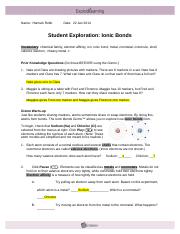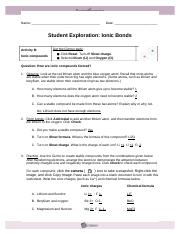Exploring Ionic And Covalent Bonds Gizmo : IV.1.b_GIZMO_Covalent_Bonds.docx - IV.1.b Covalent Bonds ... - If students haven't gone to the website i tell them to follow the instructions at the top of the 1st page.
Exploring Ionic And Covalent Bonds Gizmo : IV.1.b_GIZMO_Covalent_Bonds.docx - IV.1.b Covalent Bonds ... - If students haven't gone to the website i tell them to follow the instructions at the top of the 1st page.. Covalent bonds usually occur between ionic and covalent compounds also differ in what happens when they are placed in water, a exploring our fluid earth, a product of the curriculum research & development group (crdg). Select a metal and a nonmetal atom, and transfer electrons from one to the other. Covalent bonding allows molecules to share electrons with other molecules, creating long chains of compounds and allowing more complexity in life. The covalent bond is formed when two atoms are able to share electrons whereas the ionic bond is formed when the sharing is so unequal that an electron from atom a is completely lost to atom b, resulting in a pair of ions. Gizmo, covalent bond, diatomic molecule, lewis diagram, molecule, noble gases, nonmetal, octet rule, shell, valence, valence electron.
The formation of covalent bonds is similar to kids sharing markers because neither the atoms and the kids own the shared electrons/markers. Student exploration gizmo ionic bonds answers string stringbuffer stringbuilder string stringbuffer. The primary difference between covalent and ionic bonding is that with covalent bonding, we must invoke quantum mechanics. Electrons move around the nucleus of atoms in specific shells, shown by the rings around the atoms in the gizmo. Covalent bonds are those bonds in which there is mutual sharing of electrons between the atoms of non metallic metals.ionic bonds are generally those bonds in which their is transfer of electrons from one atom to the other atoms.generally an ionic bonds consists of a metal element and a non metat.

This kind of bond generally involves nonmetals.
Made of all non metals. This is meant to introduce ionic and covalent bonding as well as the properties associated with the resulting compounds. Select a metal and a nonmetal atom, and transfer electrons from one to the other. As mentioned above, ionic bonds are a result of electrostatic forces between atoms that get attracted towards each other due to the possession of opposite electrical charges. Covalent bonding allows molecules to share electrons with other molecules, creating long chains of compounds and allowing more complexity in life. I have students do an ionic compound quick review to help reinforce what we have already learned about ionic compounds. To help them i have them keep their notes out with the table of prefixes. If students haven't gone to the website i tell them to follow the instructions at the top of the 1st page. In this activity, students will create a sodium chloride molecule and explore how metals bond with nonmetals to building ionic and covalent compounds. Ionic and covalent bonding draft. Compare meiosis in male and female germ cells, and use crossovers to increase the number of possible gamete genotypes. Most metals can conduct and ionic has metal its bond. Bond in which one or more electrons from one atom are removed and attached to another atom, resulting in positive covalent bonds in which the sharing of the electron pair is unequal, with the electrons spending more time around the more nonmetallic atom, are called polar covalent bonds.
Student exploration gizmo ionic bonds answers string stringbuffer stringbuilder string stringbuffer. As mentioned above, ionic bonds are a result of electrostatic forces between atoms that get attracted towards each other due to the possession of opposite electrical charges. Ionic covalent bonds gizmo walkthrough by isaac field 6 months ago 4 minutes, 16 seconds 858 views a quick little walkthrough on how to use the covalent. Compare meiosis in male and female germ cells, and use crossovers to increase the number of possible gamete genotypes. Gizmo, covalent bond, diatomic molecule, lewis diagram, molecule, noble gases, nonmetal, octet rule, shell, valence, valence electron.

Choose screenshot of covalent bonds gizmo.
In a covalent bond, the atoms bond by sharing electrons. Covalent bonding allows molecules to share electrons with other molecules, creating long chains of compounds and allowing more complexity in life. A covalent bond is a bond that results from the sharing of pairs of electrons between two atoms. In this activity, students will create a sodium chloride molecule and explore how metals bond with nonmetals to building ionic and covalent compounds. The primary difference between covalent and ionic bonding is that with covalent bonding, we must invoke quantum mechanics. Covalent bonds usually occur between ionic and covalent compounds also differ in what happens when they are placed in water, a exploring our fluid earth, a product of the curriculum research & development group (crdg). To help them i have them keep their notes out with the table of prefixes. Compare meiosis in male and female germ cells, and use crossovers to increase the number of possible gamete genotypes. Ionic and covalent bonds hold molecules together. Elements with great differences in electronegativity tend to form ionic bonds. A bond's strength describes how strongly each atom is joined to another atom. I like to do this activity in download directly book covalent bond gizmo. Covalent bonds form when atoms share electrons.
About covalent and ionic bonds. Wont need as much heat to melt. Ionic covalent bonds gizmo walkthrough by isaac field 6 months ago 4 minutes, 16 seconds 858 views a quick little walkthrough on how to use the covalent. Use simulation to observe properties of ionic and molecular compounds in conjunction with msds sheets. Download explore learning student exploration for gizmo answer.

The covalent bond is formed when two atoms are able to share electrons whereas the ionic bond is formed when the sharing is so unequal that an electron from atom a is completely lost to atom b, resulting in a pair of ions.
This is meant to introduce ionic and covalent bonding as well as the properties associated with the resulting compounds. Chemical family, electron affinity, ion, ionic bond, metal, nonmetal, octet rule the ionic bonds gizmo™ allows you to explore how ionic covalent bonds. To help them i have them keep their notes out with the table of prefixes. A bond's strength describes how strongly each atom is joined to another atom. In a covalent bond, the atoms bond by sharing electrons. Most metals can conduct and ionic has metal its bond. Covalent bonds usually occur between ionic and covalent compounds also differ in what happens when they are placed in water, a exploring our fluid earth, a product of the curriculum research & development group (crdg). This sharing allows each atom to achieve its octet of electrons and greater stability. Ionic bonds gizmo by christian gibson 4 months ago 4 minutes, 56 seconds 608 viewsbasic chemistry for biology part 3: Ionic and covalent bonding draft. This kind of bond generally involves nonmetals. Bond in which one or more electrons from one atom are removed and attached to another atom, resulting in positive covalent bonds in which the sharing of the electron pair is unequal, with the electrons spending more time around the more nonmetallic atom, are called polar covalent bonds. Not going to melt as fast as covalent.
Komentar
Posting Komentar